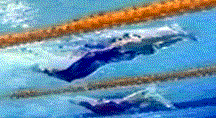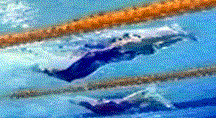HOW CHAMPIONS DO IT
Researched, produced, and prepared by Brent S. Rushall,
Ph.D., R.Psy.

INGE DE BRUIJN AT 65 m OF HER GOLD MEDAL 100 m BUTTERFLY RACE AT THE 2000 OLYMPIC GAMES IN SYDNEY
This stroke analysis includes a moving sequence in real time, a moving sequence where each frame is displayed for .5 of a second, and still frames.
The following image sequence is in real time. It will play through 10 times and then stop. To repeat the sequence, click the browser's "refresh" or "reload" button.

The following image sequence shows each frame for half a second. It will play through 10 times and then stop. To repeat the sequence, click the browser's "refresh" or "reload" button.

At the end of the following narrative, each frame is illustrated in detail in a sequential collage.
Each frame is .1 seconds apart. Inge De Bruijn's time for this race was 57.14 seconds. This sequence shows both a breathing and non-breathing stroke.
Notable features
Frame #1: Both hands enter almost touching. Usually, it is recommended that the hands enter wider than this. The legs kick to counter-balance the vertical force component of the entering arms. The torso is particularly flat, a position rarely displayed by other swimmers. It appears the entry is timed with the return of the head and shoulders into the water. That timing allows some of the pressure developed on the arms to counter-balance the "diving" head and shoulders.
Frame #2: The hands move to about shoulder-width apart. There is very little attempt to build a lift force by pitching the hands, which would be used to counter-balance a "forced" or exaggerated dive of the head and shoulders. The superb flexibility of this swimmer's shoulders can be seen because her arms have moved laterally but the shoulders remain extended forward and pressing on her head. The head and shoulders are only slightly lower than in frame #1. Her timing of the entry and goal of keeping the head and shoulders "flat" has solved the problem of excessive disruption of streamline, a feature in most butterfliers.
Frame #3: The upper arms medially rotate and elbows flex. Adduction of the upper arms begins. This "elbows-up" position starts at a position that is a lot further forward than other top butterfliers and means the length of her propulsive ("effective") pull is admirably long. Relatively speaking, her streamline is excellent for a butterflier.
Frame #4: Adduction of the upper arms occurs quite quickly. In this position, as well as the forearms and hands, the upper arms serve as part of the propulsive surface. The arms are adducting on the shoulder joints, which are also being adducted. Streamline continues to be excellent.
Frame #5: Powerful adduction of the shoulders and arms accelerates the swimmer forward. The legs prepare to kick to counter-balance the arms' exit.
Frame #6: The arms finish adducting and begin to extend. The knees drop preparatory to producing a very strong kick. One reason why this "large" kick is needed is that the swimmer's arm pull is so effective and fast, that the force of the exit requires an exceptional kick. In this series, the time for a full stroke is slightly more than one second, perhaps the highest rating of any top butterflier. She is executing a longer-than-normal effective pull at a higher rate and consequently, developing greater forces than usual.
Frame #7: A very vigorous kick is performed that counter-balances the exiting arms and elevates the hips and knees. The head remains mostly underwater.
Frame #8: The kick is completed and the knees and hips are elevated. Streamline is recaptured as the arms recover quickly.
Frame #9: As the arms recover, the hips drop slightly to start repositioning the knees preparatory to kicking on arm entry.
Frame #10: Arm-recovery continues and approaches entry. The knees drop further.
Frame #11: A position similar to that exhibited in frame #1 is achieved. One difference is that the arms enter apart, and not close together. Since the arms also enter apart in frame #21, a spread-entry is probably more characteristic of this swimmer than the hands-close-together position exhibited in frame #1.
Frame #12 through 21. The underwater mechanics of the swimmer are very similar, whether or not breathing occurs. It could be expected that streamlining would be disrupted by breathing -- perhaps the hips would drop lower, but that does not occur.
Inge De Bruijn displays several superior features in her stroking pattern.
- Streamline is very well maintained. One could postulate that there is a definite attempt to keep the head, shoulders, and hips streamlined ("flat") to a degree matched perhaps only by Mary T. Meagher (see Mary T's analyses on this web site). The early initiation of direct vertical forces, as opposed to performing an outward scull, could contribute to this desirable feature.
- The swimmer's rate is particularly high.
- The effective length of the propulsive pull is unusually long and powerful.
- The movement patterns of force production are similar whether or not breathing occurs.
The superior qualities of this stroking pattern serve to explain why Inge De Bruijn is superior in butterfly when compared to all other women swimmers.

Return to Table of Contents for this section.






